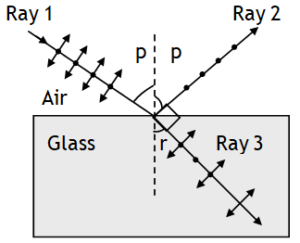^Brewster’s law
^Brewster’s law
Brewster discovered that when ordinary light is incident on the surface of a transparent medium the reflected light is partially plane polarized.

The extent of polarization depends on the angle of incidence. For a particular angle of incidence (called polarizing or Brewster angle (ip or p)
1. the reflected light is found to be completely polarized with its vibrations perpendicular to the plane of incidence.
2. the reflected & transmitted rays are perpendicular to each other, as shown in figure.
3. μ = tan p [called Brewster law
At i = p Ray 1: Incident ray (unpolarised)
Ray 2: Reflected ray (completely polarised)
Ray 3: Refracted ray (partially polarised)
For a ray incident form air to glass
aμg = 3/2, so p = tan-1 3/2 ⇒ p = 56.30
For a ray incident form air to water
aμw = 4/3, so p = tan-1 4/3 ⇒ p = 53.10
